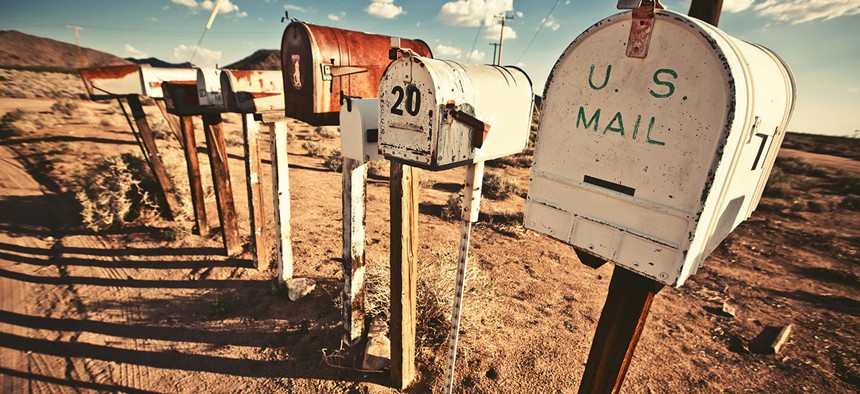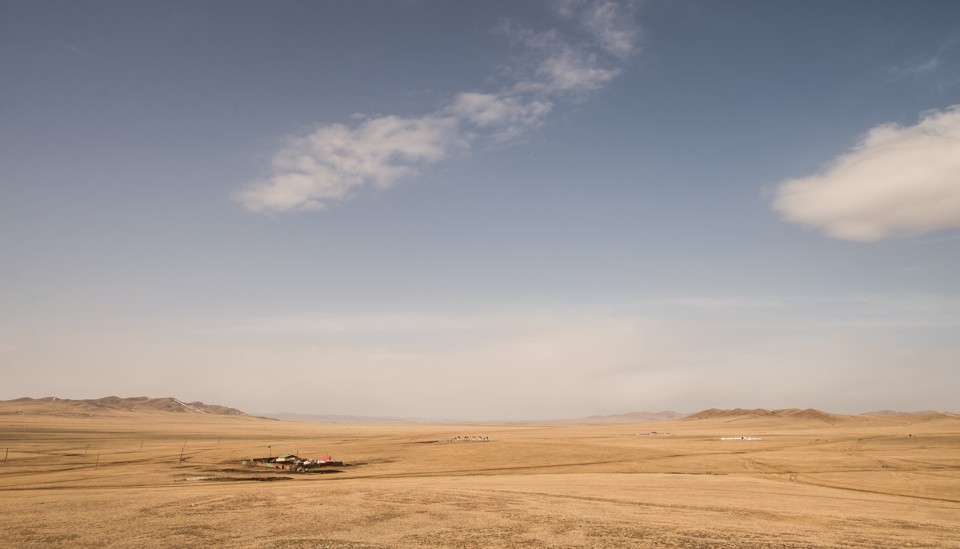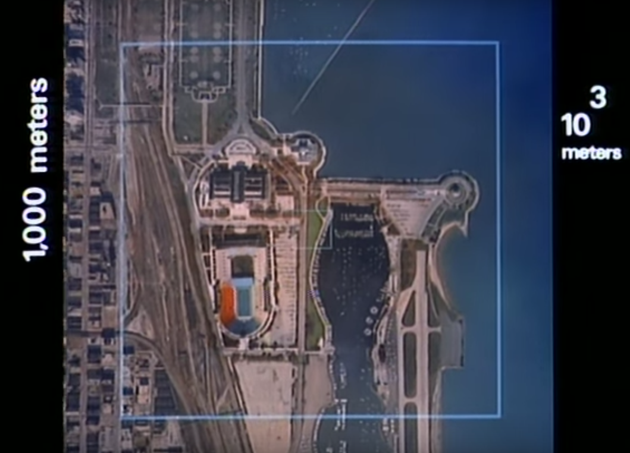The New App That Could Revolutionize How the Postal Service Delivers Mail

Andrey Bayda/Shutterstock.com
A British startup is assigning a unique name to every meter of Earth’s surface. Should addressing systems be universalized—and privatized?
There is a city in central Florida where two homes have adjoining backyards. One of the houses sits on Anna Catherine Drive; the other faces Summer Rain Drive. You could scramble under a hedge and get from one property to the other in seconds.
If you wanted to make the same journey legally, however, you had better get ready for quite the excursion. The shortest driving distance between the two front doors is 7 miles long. It includes a four-lane state highway. On a good day, the trip takes 20 minutes.
You could tell this story to indict American car culture or to explain the costs of subdivision-based development, but it’s also about something much simpler: the importance and ingenuity of postal addresses. If you tried to drive to either of those backyards using only a latitude-longitude coordinate to find them, your GPS might send you many miles off course.
This matters far beyond Florida suburbia.
“I visited a home in the Sierra mountains a few weekends ago, and it’s only approachable from a single direction. Its address doesn’t just tell [you] where it is, but also what road to take to get to the front gate,” says Michal Migurski, the vice president of Mapzen and the former chief technology officer of Code for America.
Apple doesn’t often talk about its design, and Amazon won’t sell you one, but make no mistake: Postal addresses are a technology. They are the URLs of the physical world, a standard so universally adopted that nearly every street-facing structure in the United States displays a set of integers on its front door. Addresses are so fundamental to the world that it is significantly more difficult (and often impossible) to do all the paperwork of personhood—to vote, to file taxes, to have a bank account—without being associated with one.
But if something is technological, it can be disrupted—or, at least, augmented and improved. That’s what a U.K.-based startup called What3Words is trying to do. As of last week, it has the assistance of the government of Mongolia.
What3Words envisions a universal addressing system, functional in any language, that refers to locations more precisely than street addresses can. But a set of nerds and mapping experts—people who think seriously about building a global geography infrastructure—are concerned it is making a historic mistake.
* * *
Simply put, What3Words is a grid system for the planet. In 2013, upon What3Words’s corporate founding, its leaders split Earth’s complete land and ocean surface area to 57 trillion 3-by-3 meter squares. Every individual grid square has a distinctive name, expressed as three words delineated with dots.
For example, the front door of the White House is live.linen.slower. Old Faithful, the geyser in Yellowstone National Park, is communal.frolic.pizzeria. And Four Corners Monument is beauty.reinstate.offend.
What3Words was designed to specify locations more precisely than street addresses. Chris Sheldrick, the company’s CEO, used to work as a concert organizer, and he always struggled to describe what loading dock bands should use when they showed up to a gig. What3Words, with its hyper-specificity, is meant to let people describe locations to each other without resorting to using GPS coordinates. In the ideal use-case world of What3Worlds, people text What3Words addresses to each other, then they decode them back into locations on their smartphones.
And you do have to decode a What3Words address. What3Words addresses do not naturally suggest their proximity to anything. The White House’s postal address informs you that the building is somewhere in the city of Washington, D.C.; live.linen.slower does not. What’s more, there is no free or open database of how every What3Words address lines up with a GPS coordinate. In fact, charging for access to that database is exactly how the startup What3Words makes money.
That process happens in two ways. Consumers can use the company’s app to turn locations into addresses for free. (Crucially for those beyond the reach of cell networks, the app works offline.) Businesses must either pay What3Words to use its online conversion API, or they can purchase a software development kit that will do the same thing locally on their own servers.
Sheldrick declined to discuss What3Words’s business or whether it was profitable. But its bottom line likely just received a big boost, in the form of the world’s 19th largest country.

Mongolia is a spectacularly huge and empty nation. It falls in the bottom half of countries when ranked by population, but lands in the top fifth when measured by area. Some 2.8 million people inhabit its more than 600,000 square miles—but even that is a deceptive figure, as almost half of its population lives in and around the capital, Ulaanbaatar. Mongolia is the least densely populated sovereign nation on the planet.
This presents some problems for its 900-employee postal service, officially known as Mongol Post. Even in the capital, there are few named streets, so many people write addresses based off the nearest landmark. Sometimes, people even write their cellphone numbers or a set of direction on an envelope to ensure its delivery.
What’s more, nearly a quarter of the population is nomadic, according to the World Bank and Quartz; they have no permanent address, in the Western sense of the term.
“There’s really no addresses at all for most of the country,” Sheldrick told me.
This makes a grid-based system especially appealing. Instead of trying to take advantage of a road-based infrastructure that does not exist, the Mongol Post can quickly ensure that everywhere in the territory has an address.
At least that’s what Ganhuyag Chuluun Hutagt thinks. Ganhuyag is a businessman and Mongolia’s former finance minister. Last year, he heard Sheldrick describe the What3Words system at the World Economic Forum in Davos. He was intrigued but had little ability to implement it for Mongolia.
And then suddenly he did. In January, the Mongolian government offered up 30 percent of Mongol Post in an initial privatization bid. Ganhuyag’s company, ARD Holdings, acquired about 17 percent of the organization.
“He then called me straight up and said, ‘We’d love to bring What3Words to Mongolia for Mongol Post,’” Sheldrick said.
Now he has. Last week, Mongol Post announced that What3Words will provide a national addressing system for Mongolia, “integral to its service and a part of the infrastructure that will help drive the country’s economic development.” What3Words has drafted a new, Mongolian-language version of its grid system. The announcement was first reported by Quartz.
“I have been working at the Mongol Post company for 10 years now,” said Batsaikhan Tsedendamba, the CEO of Mongol Post, in a statement. “During this time, we have been presented with numerous local and international addressing systems and technologies. Of them all, I believe what3words is the most user-friendly and optimal.”
But a set of mapping nerds is insistently asking: Optimal, sure—but optimal for whom?
* * *
To many people who work with addresses and mapping technology in the United States and the United Kingdom, What3Words seems less like a novel and revolutionary approach and more like a new way of extracting money from public coffers.
“If you just want to find a location [on What3Words], you have to go through this middleman who has exclusive control,” says Tom Lee, a data developer at Mapbox and the former director of Sunlight Labs. “That’s lousy.”
The setup reminded him of Dun & Bradstreet, a business-intelligence firm that assigned numerical IDs to other businesses in order to index them. In the early 2000s, the federal government and other organizations began using these IDs, called DUNS numbers, to organize companies that wanted to bid for contracts. This meant that even bidding on a government contract required a DUNS number.
“The goal here was basically: get the government to give us a subsidy,” said Lee. When a private company gets entangled in public infrastructure, “they can keep extracting money from anyone who has to touch it,” he told me. The U.S. government has paid Dun & Bradstreet millions to use the DUNS system.
(In a statement, a spokeswoman for Dun & Bradstreet said, “the public sector, much like the private sector, has relied on the value of Dun & Bradstreet data and standards for operational efficiency, and utilizes our data—organized by the DUNS number—for actionable insight.”)
For Leigh Dodds, a U.K. consultant who works on open-data issues, the problems only start with finding a location. Because of the terms of What3Words’ software license, someone cannot say which addresses line up with which locations without owing money to What3Words.
“Once you want to use that [What3Words] data set as a piece of infrastructure, you’re immediately hampered by licensing,” Dodds told me.
In other words, he thinks What3Words might be a fine system for labeling letters and packages. But someone could not lawfully use it to make a database of which addresses correspond to which GPS coordinates. In a blog post critical of What3Words, Dodds rattled off how this could become a problem: when describing land ownership, when running a census or statistical agency, or when mapping an area during a natural disaster.
In fact, What3Words seems to come in for almost universal criticism by U.S. and U.K. open-map developers. When word got out I was reporting this story, well-respected experts emailed me unbidden, hoping to critique the underlying technology—an eagerness to comment that I have never experienced before. Some directed me to What3Emojis, a fully functional parody of What3Words that breaks the world into trillions of triangles, each labeled with three unique emojis. Its site reads:
Addresses are hard. Who can remember street addresses or latitude/longitude pairs? You could do much better with three totally random English words, but then there’s that pesky language barrier. No system is perfect, except for emoji.
Other developers, who did not contact me, have been similarly critical:
I'm proud to announce my new distributed geolocation platform,
— Sean Gillies (@sgillies) January 13, 2016
What3Numbers! Locate anything on Earth with (long, lat, elev).
Sheldrick defended What3Words’s decision to function as a private company.
“Being a proprietary technology means we can build good technology, it means that we’re able to work in many languages, it means we’re able to market it to the world,” he told me.
He also referred me to an essay by Steve Coast, a What3Words employee and the founder of OpenStreetMap (which is essentially a worldwide Wikipedia-like map). The essay, “Why I Like What3Words,” praises the company for finding a way to identify locations beyond the street level.
“The thing that’s useful and interesting here with What3Words is that a lot of thought and time is going in to marketing and PR so people know about the problem and the solution,” Coast writes. “If you live in a western country with addresses, a functional cell phone network and you work on open mapping,” you may not appreciate the severity of the problem, he adds.
But experts’ critique tacitly assumes that What3Words is the best way to structure an addressing system for a big, empty rural place like Mongolia. Is it really?
* * *

In the West, we’re used to addresses that proceed through pleasantly expanding levels of affinity, like the zooming square in Powers of 10. American addresses follow some form of: our name, then our apartment number, then our building, then our street, then our city and state. Sometimes one or two of those steps is omitted. A ZIP code always ends the incantation.
Not all countries follow our scheme. Russian addresses don’t always move from local to national order. In Japan, few streets are named, and addresses often specify the numbered block within a certain district. Other places require multiple addresses at once: Büsingen am Hochrhein, the German town wholly enveloped by Switzerland, can receive mail addressed to either country.
In the U.S., though, not everything was once as peachy. Many farms didn’t receive any mail until the early 20th century, when the U.S. Post Office Department began experimenting with rural free delivery. At first, mail was addressed to rural customers only by their name, city and state. Local postmasters memorized the rest. It took almost half a century—from the introduction of rural free delivery in the 1890s to the first experiments with postal codes in the 1940s—for most of the country to formally join that system.
In fact, the standardization of American addressing happened much more recently than many people think.
“It’s only within the last decade that every house has a street address,” says Nancy Pope, a historian at the Smithsonian National Postal Museum. “You end up with these street addresses that are in the tens of thousands, because they’re on a rural road tens of miles from the nearest town.”
This is not to suggest that street-based addressing would work well in Mongolia. But it does hint that development of a public resource of any kind takes time.
Some people, preaching open alternatives to What3Words, have suggested Mongolia explore geohashing, an open-source way of expressing grid-based location. But these can produce unmemorable strings of data.
“Geohashes are terrible for actual location when a human needs it,” Coast argues in his essay.
Eventually, I heard arguments that pointed to another outcome: Mongolia should simply pursue a more fleshed-out addressing system, even if it’s not road-based.
After all, Migurski said, most addressing systems don’t just contain one mention of a location. Instead, they describe it with redundancy. In his email to me, he pointed out that an article about What3Words listed reporter.smoked.received as the address of the Stade de France. But if you search reporter.smoked.received on What3Words, you discover it’s in Laredo, Missouri. Reporter.smoker.received, just one letter’s difference, is the Stade.
From What3Words’s point of view, this small error reveals a feature, not a bug. What3Words addresses are designed to fail catastrophically, and therefore noticeably, Sheldrick told me. A single misplaced letter will never send a package 10 miles in the wrong direction, as a reversed digit in a latitude-longitude coordinate might. Instead, it will send it to another continent. This level of failure shows a well-designed avalanche effect in action, alerting the navigation software—or the letter carrier— that they’re heading to a likely wrong address.
* * *
Of course, all this criticism might not change Mongol Post’s decision to adopt What3Words. When talking to experts who disagreed with Mongolia’s decision, I got the sense that many of them thought What3Words was somewhat well designed, even if they disagreed with the tradeoffs it made.
Some hinted that it was just well-designed enough to be a threat: Its leaders could make strong arguments to policymakers about its simplicity and brilliance, thus gaining it entrance into the ecosystem. Once inside the ecosystem, its ownership could start extracting rents.
This does seem risky—to the point of recklessness. Designing privately owned systems into essential public infrastructure can end catastrophically. Sheldrick told me that “we look to act responsibly and give people something that works,” and I am sure they do.
But it doesn’t matter if users personally trust Sheldrick or the What3Words team. Intellectual property rights can easily change hands, and they always outlive their owners and their owners’ good intentions. By nestling its private addressing system into a necessarily public addressing system, What3Words will be too well positioned to hike its fees and charge the public. It will be too able to demand Mongolia’s growing wealth in the years and decades to come.
That will be a costly error—not only because similar schemes have gone awry in other middle-income developing nations, but because it has been our experience here, in the rich nations of the West.
In 2013 and 2015, the U.K. government cited the need for competition among letter carriers and auctioned off the entirety of the Royal Mail. After 499 years of public ownership, the national postal service went for £3.3 billion.
But as it did so, the U.K. government also sold off the copyright to the Royal Mail’s postcode registry, the database describing how specific postcodes correspond to specific street addresses. (Postcodes are largely analogous to U.S. ZIP codes.) Now, the database cannot be reproduced without the approval of the privatized Royal Mail.
It is unclear whether the U.K. sold off this database by accident. An internal government watchdog immediately denounced the sale of the registry as “an unacceptable and unnecessary consequence of privatization.” Another called it “a disaster.” But it was done.
Because of historical agreements between the postal service and the government, many government agencies can continue using the data—but with terrible limits. They cannot make the registry available in bulk to the public for free. And local governments must effectively keep the data secret. This means, for example, that a town is barred by law from releasing a dataset describing when garbage will get picked up where.
The British government is now spending £5 million to rebuild an open version of the exact same postcode registry that it sold off three years ago. It is paying to recreate a public resource that it once freely owned. Any government agency so willing to privatize its location infrastructure can expect to meet the same fate.






